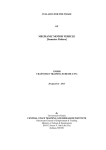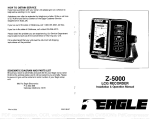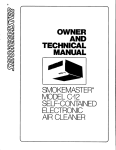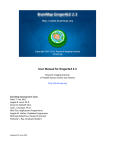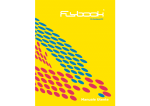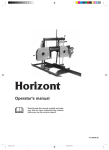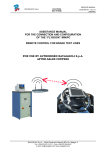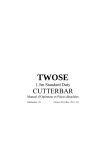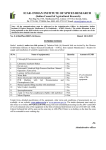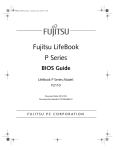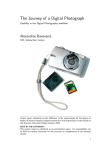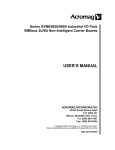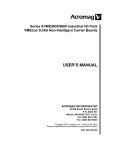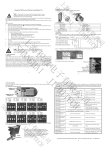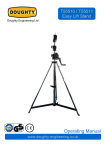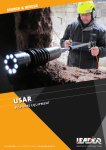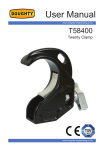Download ec declaration of conformity
Transcript
GASOLINE CHAIN SAW MT-9999 Ref no. TM5800 USER MANUAL <<original instructions>> 1 ●Before using our chain saw, please read this manual carefully to understand the proper use of your unit. ●Keep this manual handy. EC DECLARATION OF CONFORMITY We CANNON TOOLS LTD 20 Station road, Rowley Regis, West Midlands,B65 0JU.U.K. Declare that the design and construction of the following machine, in the form supplied by us, comply with the requirements of the appropriate EC directives. Product description: Gasoline Chain Saw Model: MT-9999 ●EC-Machinery directive 2006/42/EC ●EC-Directive on electromagnetic compatibility(EMC)2004/108/EC ●EC-Directives on noise emission in the environment by equipment for use outdoors 2000/14/EC,2005/88/EC Applicable harmonized EN ISO 11681-1:2011, EN ISO 14982 CANNON TOOLS LTD sign Gurcharan Tony Singh Sanghera 2014-1-6 2 EC DECLARATION OF CONFORMITY The undersigned: As authorized by : Cannon Tools Station Road, Rowley Regis, West Midlands, B65 0JU. Declares that the Name/Model: -MT9999 Gasoline Chain Saw Category of equipment as defined in EC Directive 2000/14/Annex 1.:-6 Type/Serial No.: -MT9999 Gasoline Chain Saw Electric power:Mass in kg: -N/A Cutting width: -N/A Net installed power: -N/Q Manufactured by : JINHUATEAMMAX TOOL MANUFACTURE CO.,LTD No.1299 North Second Ring Road, Jinhua, Zhejiang, China Conforms to the Directive: - 2000/14/EC Of the European Parliament and of the council on the approximation of the laws of the Member States relating to the noise emission in the environment by equipment for use outdoors. The technical documentation is kept by: Cannon Tools, Station Road, Rowley Regis, West Midlands, B65 0JU . The conformity assessment procedure followed was in according with annex (5) of the directive. Notified Body: TRAC Global, Ringwood, Hants, BH24 2DB Report No TES 003110-17 Measured sound power level: -108.8dB Engine/motor speed(mean)RPM and tolerance: Guaranteed Sound Power Level: -112.6 dB Place of Declaration: -TRAC Global, Ringwood, Hants, BH24 2db Date:5/12/2001 Signed by:Position in Company Name and address of manufacturer of Authorised representative.:Cannon Tools,Station Road, Rowley Regis, West Midlands, B65 0JU 3 SAFETY FIRST Instructions contained in warnings within this manual marked with a symbol concern critical points which must be taken into consideration to prevent possible serious bodily injury, and for this reason you are requested to read all such instructions carefully and follow them without fail. ■ NOTES ON TYPES OF WARNINGS IN THE MANUAL This mark indicates instructions which must be followed in order to prevent accidents which could lead to serious bodily injury or death. This Mark indicates instructions which must be followed, or it leads to mechanical failure, breakdown, or damage. This mark indicates hints or directions useful in the use of the product. Contents 1. PARTS LOCATION---------------------------------------------------------------- 5 2. WARNING LABELS ON THE MACHINE------------------------------------ 5 3. SYMBOLS ON THE MACHINE------------------------------------------------ 5 4. SAFETY PRECAUTIONS-------------------------------------------------------- 6 5. INSTALLING GUIDE BAR AND SAW CHAIN----------------------------- 12 6. FUEL AND CHAIN OIL----------------------------------------------------------- 13 7. OPERATING ENGINE------------------------------------------------------------ 15 8. SAWING------------------------------------------------------------------------------ 19 9. MAINTENANCE-------------------------------------------------------------------- 21 10. MAINTENANCE OF SAW CHAIN AND GUIDE BAR-------------------- 23 11. SPECIFICATIONS----------------------------------------------------------------- 26 4 1. PARTS LOCATION 1.Front guard 2.Starter knob 3.Air cleaner 4. Choke knob 5. Throttle interlock 6. Rear handle 7. Throttle trigger 8. Throttle lock button 9. Engine Switch 10. Fuel tank 11. Oil tank 12. Front handle 13. Saw chain 14. Guide Bar 15. Muffler 16. Bumper spike 17. Carburettor 18. Front handle 19. Chain brake 20. Chain tensioner 21. Chain cover/sprocket 2. WARNING LABELS ON THE MACHINE (1) Read owner’s manual before operating this machine. (2) Wear head, eye and ear protection. (3) Use the chain saw with two hands, Place left hand on front handle and right hand on rear handle. (4) Warning! Kickback is danger. (5) Warning / Attention If warning seals peel off or become soiled and impossible to read, you should contact the dealer from which you purchased the product to order new seals and affix the new seal(s) in the required location(s). 5 Never remodel the product. We won’t warrant the machine, if you use the remodelled product or proper usage in the manual is not followed. 3. SYMBOLS ON THE MACHINE For safe operation and maintenance, symbols are carved in relief on the machine. According to these indications, please be careful not to make a mistake. (a) The port to refuel the “MIX GASOLINE” Position: fuel tank cap (b) The port to refuel the “CHAIN OIL” Position: oil cap (c) The indication regarding the switch. Flipping the engine Switch to the “O”(STOP) direction, the engine stops. Position: rear-left of the unit (d) The indication regarding the choke. Pulling out the choke knob, the choke closes. Position: rear-right of the unit (e) The indication regarding the chain oil adjuster nut. “MIN” direction-the oil flow decrease “MAX” direction-the oil flow increase (f) The position of H-needle The position of L-needle The Position of idle adjusting screw Position: rear-left of the unit SAFETY PRECAUTIONS ■BEFORE USING THE MACHINE a. Read this owner’s manual carefully to understand how to operate this unit properly. b. You should never use the product when under the influence 6 of alcohol, when suffering from exhaustion or lack of sleep, when suffering from drowsiness as a result of having taken cold medicine, or at any other time when a possibility exists that your judgment might be impaired or that you might not be able to operate the machine properly and in a safe manner c. Avoid running the engine indoors. The exhaust gases contain harmful carbon monoxide. d. Never use the product under circumstances like those described below 1.When the ground is slippery or when other conditions exist which might make it not possible to maintain a steady posture. 2.At night, at times of heavy fog, or at any other times when your field of vision might be limited and it would be difficult to gain a clear view of the area. 3.During rain storms, during lightning storms, at times of strong or gale-force winds, or at any other times when weather conditions might make it unsafe to use this product. e. When using this product for the first time, before beginning actual work, learn to handle it from a skilled worker. f. Lack of sleep, tiredness, or physical exhaustion results in lower attention spans, and this in turn leads to accidents and injury. Limit the amount of time of using the machine continuously to somewhere around 10 minutes per session, and take 10 – 20 minutes of rest between work sessions. Also try to keep the total amount of work performed in a single day under 2 hours or less. g. Failure to take proper breaks can cause injury including risk of white finger as well as leak concentration or loss of balance. h. Be sure to keep this manual handy so that you may refer to it later whenever any questions arise. I. Always be sure to include this manual when selling, lending, or otherwise transferring the ownership of the product. J. Never allow children or anyone unable to fully understand the directions given in this manual to use this product. ■WORKING GEAR AND PROTECTIVE CLOTHING a. When using the product, you should wear proper clothing and protective equipment as follows. (see overleaf) 7 (1) Safety Helmet EN397 (2) Protective goggles or reinforced Face Protector EN166,EN1731 (3) Thick protective gloves with reinforced left hand EN381-7 (4) Leg protection, outer clothing high visibility and upper body Protection EN381-5, EN381-11 (5) Chain saw boots BS EN ISO 20345:2004, EN 381-3, EN381-9 (6) Ear protectors: Sound power level: 111.2dB(A), EN352-1 Please wear ear protectors. b. And you should carry with you. 1. First Aid kit 2. Attached tools and files. 3. Properly reserved fuel and chain oil. 4. Things to notify your working area (Rope, warning signs) 5. Whistle, mobile phone/ radio for emergency contact 6. Hatchet or saw (for removal of obstacles ie fallen branches c. Never use the product wearing sandals/when barefoot and always wear anti-snag clothing ■WARNING: HANDLING OF FUEL a. The engine of this product is designed to run on a mixed fuel which contains highly flammable gasoline. Never store cans of fuel or refill the fuel tank in any place where there is a boiler stove, wood fire, electrical sparks, welding sparks, or any other source of heat or fire which might ignite the fuel. b. Smoking while operating the product or refilling its fuel tank is extremely dangerous. Always be sure to keep lit cigarettes away from the product at all time. c. When refilling the tank always turn off the engine first and take a careful look around to make sure that there are no sparks or open flames anywhere nearby before refueling. d. If any fuel spillage occurs during refuelling, use a dry rag to wipe up spills before turning the engine back on again. e. After refuelling, screw the fuel cap back tightly onto the fuel tank and then carry the product to a spot 3m or more away from where it was refuelled before turning on the engine. ■FUELLING INSTRUCTION: Only fuel your chainsaw in a well ventilated area f. Gasoline vapour is invisible and can travel, be careful if there are any spillages of fuel. g. Gasoline vapour pressure may also build up in the fuel tank .Be very careful in hot weather. h. Remember to take special care when removing filler caps. Never remove them when the engine is running. 8 ■BEFORE STARTING ENGINE Note: always check you know how to stop the chain saw. Always ensure there is no damage to the front guard and chain brake and that the handles and anti-vibration insulation are not damaged Always check the throttle only opens when throttle lock pushed in Always check the chain is the correct chain for the chainsaw as recommended by the manufacturer as this reduces the danger of kickback Check working place, the cutting object and cutting direction. Remove any obstacles Never start cutting until you have a clear work area, secure footing and planned retreat path from the falling tree. Use caution and keep bystanders and animals out of the working area ie a diameter of 2.5 times of the cutting object. Inspect the machine for worn, loose, or damaged parts. Never operate a machine that is damaged, improperly adjusted, or is not completely and securely assembled. Make sure the saw chain stops moving when the throttle control trigger is released. ■WHEN STARTING THE ENGINE Only 1 person should operate the chainsaw at any one time Assess the risks of the intended work area and notify others show may be in the area or on the site Always ensure there is a safe distance between you and other workers Always have a person available who is designated to contact the emergency services in an emergency Always hold the machine firmly with both hands when the engine is running. Use a firm grip with thumb and fingers encircling the handle. Keep all parts of your body away from the machine when the engine is running. Before starting the engine, make sure the saw chain is not contacting anything. ■OPERATION ●Keep the handle dry, clean and free of oil or fuel mixture. ● Never touch the muffler, spark plug or the metallic parts of the engine while the engine is in operation or immediately after stopping the engine. Doing so could result in serious burns or electrical shock. ● Use extreme caution when cutting small size brush and saplings because slender material may catch the saw chain and be shipped toward you or pull you off balance. ● When cutting a limb that is under tension, be alert for spring back to that you won’t be struck when the tension in the wood fibers is released ● Check the tree for dead branches that could fall during felling ● Always shut off the engine before setting it down. ● Beware of mist from oil lubrication. ● Be careful of inhaling saw dust or getting it into your eyes when cutting wood. 9 ■ TRAINING Medical Conditions: When operating the chainsaw you should ensure that you are fit and healthy both physically and mentally . You need to seek medical advice if you have any condition that may affect you such issues with your mobility, heart conditions and vision. If you have any condition that affects your cognitive ability or strength you need to seek medical advice. Age: No one under the aged of 16 years can operate a chainsaw. Health Risk : Always ensure that adequate precautions are taken as there are a number or health risks associated from noise and vibration such as loss of hearing and white finger These risks need to be controlled. Always ensure that the proper protective clothing is worn please see Pages 7-8 and always check the safety features on the chainsaw such as the anti vibration insulation on the handles. Training and Training Courses: Always remember that anyone operating a chain saw must have proper training and should be competent to use the chainsaw. You will need to be trained about the dangers of the chainsaw itself and the dangers from operating the chainsaw incorrectly . i.e kick back skating and bouncing and the dangers that can arise from the work that you are undertaking with your chainsaw. You should be aware of steps and precautions i.e safe practices to minimise these risks. When using the chainsaw for felling trees you need to hold a certificate or a competence award. There are exceptions to this if you are the owner / occupier or employed in agricultural work or that you have used a chainsaw before 5 December 1998. Always ensure that whoever (you or any other chainsaw operator) uses the chainsaw in agricultural work or any other type of work, that person MUST be competent under PUWER 98(the Approved Code of Practice supporting regulation 9 of the Provision and Use of Work Equipment Regulations 1998) Training MUST be carried out by fully accredited and specialist instructors . Please see Sector Skills Council and refresher courses should be attended for occasional users every 2 to 3 years and full time users every 5 years. Always ensure that you maintain your level of skill to operate the chainsaw. ■KICKBACK SAFETY PRECAUTIONS FOR CHAIN SAW USERS ●Kickback may occur when the nose or tip of the guide bar touches any object, or when the wood closes in and pinches the saw chain in the cut. Tip contact in some cases may cause a lightning fast reverse reaction, kicking the guide bar up and back towards the operator. Pinching the saw chain along the top of the guide bar may push the guide bar rapidly back towards the operator. Either of these reactions may cause you to lose control of the saw which could result in serious personal injury. 10 Do not rely only on the safety devices built into your saw. As a Chain saw user you should take several steps to keep cutting jobs free from accident or injury. With a basic understanding of kickback you can reduce or eliminate the element of surprise. Sudden surprise contributes to accidents. Keep a good grip on the saw with both hands, the right hand on the rear handle, and the left hand on the front handle, when the engine is running. Use a firm grip with thumbs and fingers encircling the chain saw handles. A firm grip will help you reduce kickback and maintain control of the saw. Make certain that the area in which you are cutting is free from obstructions. Do not let the nose of the guide bar contact a log/,branch, or any other obstruction which could be hit while you areoperating the saw. Cut at high engine speed. Never operate the chainsaw without a front guard; thisprotects youfrom kickback Remember the chain brake is there to reduce the risk of injury. Always maintain the chain brake. Do not overreach or cut above shoulder height. Follow manufactures sharpening and maintenance instructions for saw chain. Only use replacement bars and chains specified by the manufacturer or the equivalent. ■MAINTENANCE In order to maintain your product in proper working order, perform the maintenance and checking operations described in the manual at regular intervals as stated. Always be sure to turn off the engine before performing any maintenance or checking procedures. The Metallic parts reach high temperatures immediately after stopping the engine. Leave all maintenance other than the items listed in the owner’smanual to your competent servicing dealer. ■TRANSPORTATION Always carry the unit with the engine stopped, the guide bar covered with the protector to the rear, and muffler away from your body, to avoid burns avoid touching the surface of the muffler and hot parts of the machine. Transportation by vehicle Always secure the saw to prevent it rolling over and causing fuel spillage and damage to saw. When not in use store the saw in a safe place. 11 4. INSTALLING GUIDE BAR AND SAW CHAIN A standard saw unit package contains the items as the items as illustrated. (F1) (1) Power unit (2) Bar protector (3) Guide bar (4) Chainsaw (5) Plug wrench (6) Screwdriver for carburetor adjustment (7) Spike and mounting screws Open the box and install the guide bar and the saw chain on the power unit as follows: The saw chain has very sharp edges. Usethick protective gloves for safety. 1. Pull the hand guard towards the front handle to disengage and to check that the chain brake is not on. 2. Loosen the nuts to take off the chain sprocket cover. 3. Turn screws anti-clockwise til tensioner nut is resting against the end of the sprocket cover. 4. Note: chain pitch must match the pitch of the sprocket. (see specifications p.21 point 14) 5. Ensure bumper spike is installed and attached to the power unit, then fix the screw in Accessories. 6. Guide chain to the sprocket and fit saw chain and guide bar. Mount the guide bar to the power unit, turn the tensioning screw clockwise until the chain is no longer sagging on the underside of the bar, adjusting the position of chain tensioner nut on the chain cover to the lower hole of guide bar.(F2) 7. Refit the chain sprocket cover. (8) Hole (9) Tensioner nut (10) Chain cover 12 Pay attention to the correct direction of thesaw chain.(F3) (1) Moving Direction – Tensioning the saw 8. Fit the chain sprocket cover to the power unit and fasten the nuts to finger tightness. 9. While holding up tip of the bar, adjust the chain tension by turning the tensioner screw until the tie straps just touch the bottom side of the bar rail.(F4) 10. Tighten the nuts securely with the bar tip held up(12~15N.m). Check chain for smooth rotation, proper tension while moving it by hand. If necessary, readjust with the chain cover loose. 11. Tighten the tensioner screw. (2) Loosen (3) Tighten (4) Tensioner screw 12. If you re-tension the chain during cutting work always shut off the engine and always wear gloves. Note: a new chain may have to be re-tensioned more than one that has been used. A new chain will expand its length in the beginning of use. Check and readjust the tension frequently as a loose chain easily derail or cause rapid wear of itself and the guide bar. Should you need to replace chain on the chainsaw of the guide bar please only buy approved products and install them as above. 6. FUEL AND CHAIN OIL ■ FUEL (see F5) Mix a regular gasoline (leaded or unleaded, alcohol-free) and a quality-proven motor oil for air cooled 2 cycle engines. 13 Recommended mixing ratio: Condition: Gasoline: Oil: Up to 20 hours use 20:1 After 20 hours use 25:1 25:1 Mix Chart Gasoline litres 1 2 3 4 2-cycle oil nl. 40 80 120 160 5 200 Keep open flames away from the area where fuel is handled or stored. Mix and store fuel only in an approved gasoline container. Most engine troubles are caused, directly or indirectly, by the fuel used on the machine, Take special care not to mix a motor oil 4 cycle engines. ■CHAIN OIL (see F6) Use motor oil SAE#10W~30 all year round or SAE #30~#40 in summer and SAE #20 in winter. Do not use wasted or regenerated oil that can cause damage to the oil pump. 14 7. OPERATING ENGINE ■STARTING ENGINE 1.Fill fuel and chain oil tanks respectively, and tighten the caps securely.(F7) 2.Put the switch to “I” position.(F8) 3.While holding the throttle lever together with the throttle interlock, push in the side throttle lock button and release the throttle lever to hold it at the starting position.(F9) (1) Chain oil (2) Fuel (3) Switch (4) Throttle lock button (5) Throttle lever (6) Throttle interlock (7) Choke knob 4.Pull out the choke knob to the closed position.(F10) When restarting immediately after stopping the engine, leave the choke knob at the open position. 5. While holding the saw unit securely on the ground, pull the starter rope vigorously.(F11) Do not start the engine while hanging the chain saw with a hand. The saw chain may touch your body. It’s very dangerous. 6.When engine has ignited first, push in the choke knob and pull the starter again to start the engine 7.Allow engine to warm up with throttle lever pulled slightly. Keep clear of saw chain - it will start rotating on starting engine. ■CHECKING OIL SUPPLY After starting the engine, run the chain at medium speed and see if chain oil is scattered off as shown in the figure.(F12) 15 (1)Chain oil The chain oil flow can be changed by inserting a screwdriver in the hole on bottom of the clutch side. Adjust according to your work conditions. (F13) (1) Adjuster The oil tank should become nearly empty by the time fuel is used up. Be sure to refill the oil tank every time when refuelling the unit. ■ADJUSTING CARBURETTOR(F14) The carburettor on your unit has been factory adjusted, but may require fine tuning due to change in operating conditions. Before adjusting the carburettor, make sure that provided are clean air/fuel filters and fresh, properly mixed fuel. When adjusting, take the following steps: Be sure to adjust the carburettor with the bar chain attached 1.Stop engine and screw in both H and L needles until they stop. Never force. Then set them back the initial number of turns as shown below. 3 H needle: 1 /8 1 L needle: 1 /4 2.Start engine and allow it to warm up at half-throttle. 3.Turn L needle slowly clockwise to find a position where idling speed is maximum, then set the needle back a quarter (1/4) turn counterclockwise. 4.Turn idle adjusting screw (T) counterclockwise to that saw chain does not turn. If idling speed is too slow, turn the screw clockwise. 16 5.Make a test cut and adjust the H needle for best cutting power, not for maximum speed. (1) L needle (2) H needle (3) Idle adjusting screw ■CARBURETTOR ANTI-FREEZE MECHANISM Operating the chain saw in temperatures of 0-5℃ at times of high humidity may result in ice forming within the carburettor, and this in turn may cause the output power of the engine to be reduced or for the engine to fail to operate smoothly. This product has accordingly been designed with a ventilation hatch at the back of the air cleaner cover to allow warm air to be supplied to the engine and to thereby prevent icing from occurring. Under normal circumstances the product should be used in normal operating mode,i.e., in the mode to which it is set at the time of shipment. However when the possibility exists that icing may occur, the unit should be set to operate in anti-freeze mode before use.(F15) ■HOW TO SWITCH BETWEEN OPERATING MODES (F15) 1.Flip the engine switch to turn off the engine. 2.Remove the air cleaner cover from the cylinder cover 3.Loosen a screw and remove the screen on the back of the air cleaner cover. 4.Reattach the screen right side left so as to the anti-icing plate is on the right. Reinstall the cover. (1) Air cleaner cover (2) Anti- icing plate (3) Screw (4) Normal operating mode (5) Anti-freeze mode (6) Screen 17 Continuing to use the product in anti-freeze mode even when temperatures have risen and returned to normal may result in the engine failing to start properly or in the engine failing to operate at its normal speed, and for this reason you should always be sure to return the unit to normal operating mode if there is no danger of icing occurring. When using the saw with the anti- freeze mode. Frequently check the screen and keep it clean of saw dust. ■CHAIN BRAKE This machine is equipped with an automatic brake to stop saw chain rotation upon occurrence of kickback while in saw cutting operation. The brake is automatically operated by inertial force which acts on the weight fitted inside the front guard. This brake can also be operated manually with the front guard turned down to the guide bar.(F16) To release brake, pull up the front guard toward the front handle until a “click” sound is heard. Caution】 Be sure to confirm brake operation on the daily inspection How to confirm: (1)Turn off the engine. (2)Holding the chain saw horizontally, release your hand from the front handle, hit the tip of the guide bar to a stump of a piece of wood, and confirm brake operation. Operating level varies by bar size (F17) In case the brake is not effective, ask the dealer to inspection and repair. The engine, if being kept rotated at high speed with the brake engaged may heat the clutch and cause difficulty. When the brake is operated while in operation, immediately release your fingers from the throttle lever and keep the engine idling. ■ STOPPING ENGINE 1. Release the throttle lever to allow the engine idling for a few minutes. 2. Put the switch to the “O”(STOP) position.(F18) (1) Switch 18 8.SAWING Before proceeding to your job, read “For Safe Operation” section. It is recommended to first practice sawing easy logs. This also helps you get accustomed to your unit. Always follow the safety regulations. The chain saw must only be used for cutting wood. It is forbidden to cut other types of material. Vibrations and kickback vary with different materials and the requirements of the safety regulations would not be respected. Do not use the chain saw as a lever for lifting, moving or splitting objects. Do not lock it over fixed stands. It is forbidden to hitch tools or applications to the P.t.o. that are not specified by the manufacturer. It is not necessary to force the saw into the cut. Apply only pressure while running the engine at full throttle. When the saw chain is caught in the cut, do not attempt to pull it out by force, but use a wedge or a lever to open the way. Use a spiked bumper when cutting trees and thick branches. Run the engine on full throttle and be sure that the spiked bumper is engaged firmly in to the wood before you start cutting. Do not work without the spiked bumper being engaged as the saw may pull you forwards and this is very dangerous. The chain may pinch on the wood pulling the saw forward. Always ensure that the spiked bumper is held securely against the tree or branch. Only use the chain saw for cutting wood. Do not try to cut any other materials this is highly dangerous. GUARD AGAINST KICKBACK (F19) This saw is equipped with a chain brake that will stop the chain in the event of kickback if operated properly. You must check the chain brake operation before each usage by the saw at full the throttle for 1-2 seconds and pushing the front hand guard forward. The chain should stop immediately with the engine at full speed. If the chain is slow 19 to stop or does not stop, replace the brake band and clutch drum before use. ● It is extremely important that the chain brake be checked for proper operation before each use and that the chain be sharp in order to maintain the kickback safety level of this saw. Removal of the safety devices, inadequate maintenance, or incorrect replacement of the bar or chain may increase the risk or serious personal injury due to kickback. ■ FELLING A TREE(F20) 1. Decide the felling direction considering the wind, lean of the tree, location of heavy branches, ease of job after felling and other factors 2. While cleaning the area around the tree, arrange a good foothold and retreat path. 3. Make a notch cut one-third of the way into the tree on the felling side. 4. Make a felling cut from the opposite side of the notch and at a level slightly higher than the bottom of the notch. When you fell a tree, be sure to warn your neighbouring workers of the danger. (1)Notch cut (2)Felling cut (3)Felling direction ■Bucking and limbing Bucking is the process of cutting the tree into usable lengths, limbing is removing unwanted limbs(branches) from standing timber or a tree that is lying on the ground. Both procedures run the risk of kick back if the chainsaw is not held correctly or held with one hand only. Warning there is an extreme danger of kickback or that the saw will skate or bounce on contact with an uneven part of the branch or log. Never work with the nose of the bar in either action. When bucking never stand on the log and make sure that avoid running the chainsaw in to the ground. ●Always ensure your foothold. Do not stand on the log. ●Be alert to the rolling over of a cut log. Especially when 20 working on a slope, stand on the uphill side of the log. ●Follow the instructions in “For safe Operation” to avoid kickback of the saw. Before starting work, check the direction of bending force inside the log to be cut. Always finish cutting from the opposite side of bending direction to prevent the guide bar from being caught in the cut. A Log lying on the ground (F21) Saw down halfway, then roll the log over and cut from the opposite side. A Log hanging off the ground (F22) In area A, saw up from the bottom one-third and finish by sawing down from the top. In area B, saw down from the top one-third and finish by sawing up from the bottom. Cutting Limb of Fallen Tree (F23) First check to which side the limb is bent. Make the initial cut from the bent side and finish by sawing from the opposite side. Be alert to the springing back of a cut limb. Pruning of Standing Tree(F24) Cut up from the bottom, finish down from the top. ● Do not use an unstable foothold or ladder. ● Do not overreach. ● Do not cut above shoulder height. ● Always use your both hands to grip the saw. 9. MAINTENANCE Different maintenance items may need attention at different times. Please see below regarding individual aspects. Before cleaning, inspecting, or repairing your unit, make sure that the engine has stopped and is cool. Disconnect the spark plug to prevent accidental starting. Cover the guide bar with the protector to the rear and the muffler and engine hot parts Transportation by vehicle: Always secure the saw to prevent it rolling over and causing fuel spillage and damage to saw. When not in use store the saw in a safe place. 21 ■MAINTENANCE AFTER EACH USE 1. Air filter Dust on the cleaner surface can be removed by tapping a corner of the cleaner against a hard surface. To clean dirt in the meshes ,split the cleaner into halves and brush in gasoline, When using compressed air, blow from the inside.(F25) 2.Oiling port Dismount the guide bar and check the oiling pot for clogging.(F26) 3.Guide bar When the guide bar is dismounted, remove saw dust in the bar groove and the oiling port.(F27) Grease the nose sprocket from the feeding port on the tip of the bar. (F28) (1) Oiling port (2) Grease port (3) Sprocket 4. Others Check for fuel leakage and loose fastenings and damage to major parts. Especially handle joints and guide bar mounting, If any defects are found, make sure to have them repaired before operation again. Check daily and also if the product is ever dropped or suffers any impact. ■PERIODICAL SERVICE POINTS 1.Cylinder fins’ Dust clogging between the cylinder fins will cause overheating of the engine. Periodically check and clean the cylinder fins after removing the air cleaner and the cylinder cover. When installing the cylinder cover, make sure that switch wires and grommets are positioned correctly in place. (F29) Be sure to block the air intake hole. 2.Spark plug (F30) Clean the electrodes with a wire brush and reset the gap to 0.65mm as necessary. 3.Sprocket (F31) (pto) Check for cracks and for excessive wear interfering with the chain drive. If excessive wearing is found, replace the chain 22 drive with a new one, never fit a new chain on a worn sprocket, or a worn chain on a new sprocket. (1) Sprocket (2) Needle bearing (3) Clutch drum (4) Spacer (5) Clutch shoe 4. Fuel Filter Disassemble the filter and wash with gasoline, or replace with new one if needed. 5. Oil filter Disassemble the filter and wash with gasoline or replace with new one if needed. 6. Front and Rear dampers Replace if adhered part is peeled or crack is observed on the rubber part. 7. Clutch Check periodically there is no chain movement at idling speed. If necessary please adjust idling speed as explained above under adjusting carburetor F14 page 16 of manual. 10. MAINTENANCE OF SAW CHAIN AND GUIDE BAR. ■SAW CHAIN It is very import for smooth and safe operation to keep the cutters always sharp. Your cutters need to be sharpened when: ●Sawdust becomes powder-like. ●You need extra force to saw in. ●The cut way does not go straight ●Vibration increases ●Fuel consumption increases Cutter setting standards: Be sure to wear safety gloves. Before filling; 23 ●Make sure the saw chain in held sccurely ●Make sure the engine is stopped ●Use a round file of proper size for your chain. Chain type: 21VB File size: 3/16 in (4.76mm) Place your file on the cutter and push straight forward. Keep the file position as illustrated. (F32). After every cutter has been set, check the depth gauge and Be sure to round off the front edge to reduce the chance of file it to the proper level as illustrated. (F33) kickback or tie-strap breakage. (1) Appropriate gauge checker (2) Make the shoulder round (3) Depth gauge standard Make sure every cutter has the same length and edge angles as illustrated (F34). (4) Cutter length (5) Filing angle (6) Side plate angle (7) Top plate cutting angle Only use guide bar provided and not any non approved guide bar as it may be unsafe in operation. ■ GUIDE BAR ●Reverse the bar occasionally to prevent partial wear. ●The bar rail should always be a square. Check for wear of the bar rail. Apply a ruler to the bar and the outside of a cutter. If a gap is observed between them the rail is normal. Otherwise, the rail is worn. Such a bar needs to be corrected or replaced. (F35) PTO (1) Ruler 24 (2) Gap (3) No gap (4) Chain tilts MAINTENANCE CHECK LIST Some maintenance items must be carried out before EVERY use of the chainsaw and others are, for example, monthly. READ ALL MAINTENANCE REQUIREMENTS CAREFULLY ●Always ensure maintenance is carried out in accordance with the guidelines in your operating manual ●Always ensure cutter lengths and angles are equal. ●Check the chain for abnormal wear and damage every 2 months. ●Always check the drive sprocket for wear and damage ●Always check anti vibration insulation (rubber coverings to handles) (white finger) replace if necessary as specified. ●Always remember that when cleaning the chain saw only use non flammable cleaning solution. Never use petrol to clean your chainsaw. ●Clean the chainsaw after each use. ●Always check the chain brake before starting work and after refuelling ●Check the fuel filter at regular intervals or replace when necessary ●Clean fuel tank regularly at monthly intervals ●Clean chain oil tank regularly at monthly intervals and change the oil every 6 months ●Check chain lubrication regularly ●Check the clutch every 6 months ●Always check the saw chain before commencing work and after refuelling and after refuelling remember to check the chain lengths and chain sharpness. Always wear gloves. ●Check the guide bar for wear and damage and clean. Replace if damaged. ●Always check air filter clean if blocked and replace if damaged. ●Always check the anti vibration insulation for the handles. Replace if damaged in any way. ●Be aware of you operating environment i.e if particularly hot weather; a particularly dusty environment or certain types of timber may effect the functioning of your chainsaw. 25 SPECIFICATIONS 1 Chain saw Model MT-9999 2 Maximum engine power 2.2KW 3 Maximum engine speed 7500 MIN 4 Maximum engine speed with cutting 10000rpm = 20.4 m/s -1 attachment 5 Maximum engine speed at idling 3000rpm = 0 m/s when idling 6 Measured clutch engagement speed 3750rpm = 13 m/s (1.25x3000 rpm) 7 Fuel Mixture (Gasoline 25: Two-cycle oil 1) 8 Fuel tank capacity 550cm 3 9 Oil tank capacity 260cm 3 10 Engine displacement 53cm 11 Maximum cutting length 48(cm) 12 Dry weight 4.75(kg) 13 Sprocket 7TX0.325 14 Saw chain pitch 8mm 15 Saw chain teeth 76teeth 16 Saw chain gauge 15.mm 17 Guide bar size 16 18 Sound pressure level LpA=91.2dB(A0, K=3.49dB(A) 19 Sound power level LwA=111,2dB(A), K=3.49dB(A) 20 Vibration measurement 3 18 20 in 2 2 2 2 Front handle: 15.108m/s , k=1.5m/s Rear handle: 11.372m/s , k=1.5m/s 26 CANNON TOOLS LTD 20 Station Road, Rowley Regis, West Midlands, B65 0JU, U.K. Made in China 27



























